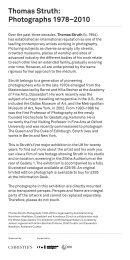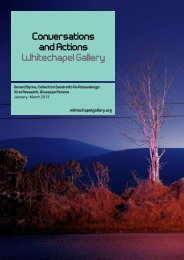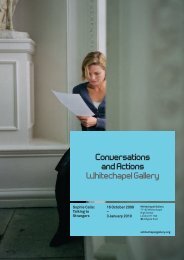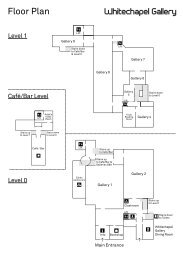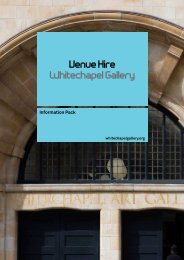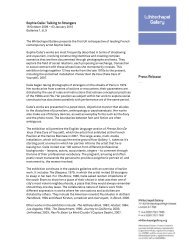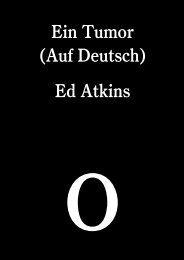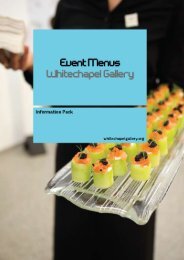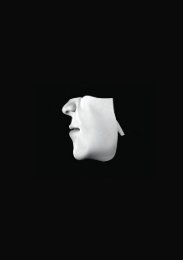Alice Neel: Painted Truths 8 July - Whitechapel Gallery
Alice Neel: Painted Truths 8 July - Whitechapel Gallery
Alice Neel: Painted Truths 8 July - Whitechapel Gallery
You also want an ePaper? Increase the reach of your titles
YUMPU automatically turns print PDFs into web optimized ePapers that Google loves.
<strong>Alice</strong> <strong>Neel</strong>: <strong>Painted</strong> <strong>Truths</strong>8 <strong>July</strong> – 17 September 2010, Galleries 1, 8 & 9.The <strong>Whitechapel</strong> <strong>Gallery</strong> presents the first major retrospective ofinfluential 20 th century American painter <strong>Alice</strong> <strong>Neel</strong>.<strong>Alice</strong> <strong>Neel</strong> (1900–1984) is best known for her portraits of celebratedartists and writers from New York, including Andy Warhol, FrankO’Hara, Meyer Shapiro and Linda Nochlin.A self-proclaimed ‘collector of souls’, she painted friends, family andneighbours in the Manhattan district of Spanish Harlem, delving intotheir personalities with rare frankness. Undeterred by a turbulentpersonal life that included a year of hospitalisation following a nervousbreakdown, and the destruction in 1934 of over 250 paintings anddrawings, it was only in her later years that she gained widespreadrecognition.At a time when New York witnessed the birth of AbstractExpressionism, Minimalism and Pop Art, <strong>Alice</strong> <strong>Neel</strong> pursued the lessfashionable discipline of painting people, and was a key force inreviving portraiture in the 20 century. She became a figure-head for theFeminist movement and is now much admired by a generation ofyounger artists including Peter Doig, Marlene Dumas, Chris Ofili, andElizabeth Peyton.Shown for the first time in Europe are 60 major works spanning sevendecades of <strong>Alice</strong> <strong>Neel</strong>’s career. They include a portrait of Andy Warhol,who was famously sensitive about his ordinary looks and bad skin,which reveals the scars of his 1968 gunshot wounds. The exhibition isdivided into sections according to <strong>Neel</strong>’s thematic preoccupations:allegory, the essential portrait, the psychological portrait, portraitsfrom memory, cityscapes, nudes, parents and children, the detachedgaze, and old age. In addition, two archival films are on show; an eightminutesilent film by <strong>Neel</strong>’s son Hartley, documenting the artistpainting her daughter-in-law Ginny, and Michel Auder´s film showing<strong>Neel</strong> painting Margaret Evans Pregnant.Notes for Editors• <strong>Alice</strong> <strong>Neel</strong> (1900-1984) was born in rural Pennsylvania. On ascholarship she attended the first women-only art school inAmerica (now Moore College of Art and Design), where sheexcelled at figurative painting. The early loss of her twodaughters, the first to diphtheria and the second to her formerhusband’s family in Cuba, led to a nervous breakdown, and <strong>Neel</strong>was hospitalised. A few months after her release, <strong>Neel</strong> settleddown to eke out an artist’s existence in Greenwich Village (NewYork).,. In 1938, <strong>Neel</strong> moved to Spanish Harlem to ‘find moretruth’ continuing to paint family, friends, and neighbours. Upon
moving to the Upper West Side in 1962, <strong>Neel</strong> began to re-engagewith the New York art world. At age 74 <strong>Neel</strong> was recognised with asolo exhibition at the Whitney Museum of American Art.• <strong>Alice</strong> <strong>Neel</strong>: <strong>Painted</strong> <strong>Truths</strong> has been organised by the Museum ofFine Arts, Houston. Generous funding has been provided by TheNational Endowment for the Arts. The exhibition is at Museum ofFine Arts, Houston (21 March - 13 June 2010) and will tour toModerna Museet, Malmö, Sweden (10 October 2010 - 2 January2011).• <strong>Alice</strong> <strong>Neel</strong>: <strong>Painted</strong> <strong>Truths</strong> is supported by the Estate of <strong>Alice</strong> <strong>Neel</strong>and Terra Foundation. With additional support from David Zwirnerand Victoria Miro.• <strong>Alice</strong> <strong>Neel</strong>: <strong>Painted</strong> <strong>Truths</strong> will be accompanied by a fullyillustrated catalogue of the same title published by the MFAH anddistributed by Yale University Press. The catalogue containsmajor essays by art historians Tamar Garb and Robert Storr, aswell as by curators Lewison and Walker, who also contributechapter introductions and entries on each work. In addition, threeshort appreciations are included by artists who admire <strong>Neel</strong>:Frank Auerbach, Marlene Dumas, and Chris Ofili.• Media Partner: Classic FM.Visitor InformationOpening times: Tuesday – Sunday, 11am – 6pm, Thursdays, 11am – 9pm.Tickets: £8.50/£6.50 concs. Book Now*:+44(0)844 412 4309 * Fee £1 per ticket.<strong>Whitechapel</strong> <strong>Gallery</strong>, 77 – 82 <strong>Whitechapel</strong> High Street, London E1 7QX. NearestLondon Underground Station: Aldgate East, Liverpool Street, Tower Gateway DLR.T + 44 (0) 20 7522 7888 info@whitechapelgallery.org whitechapelgallery.orgPress InformationThe media view for <strong>Alice</strong> <strong>Neel</strong>: <strong>Painted</strong> <strong>Truths</strong> is at 10am on Wednesday 7<strong>July</strong> 2010.For further press information please contact:Rachel Mapplebeck on 020 7522 7880, 07811 456 806 or emailRachelMapplebeck@whitechapel.orgElizabeth Flanagan on 020 7522 7871 or emailElizabethFlanagan@whitechapelgallery.org
<strong>Alice</strong> <strong>Neel</strong>: <strong>Painted</strong> <strong>Truths</strong>8th <strong>July</strong>–17 September 2010, <strong>Whitechapel</strong> <strong>Gallery</strong>1. 2. 3.4.5. 6. 7.8.9. 10.11. 12.1.<strong>Alice</strong> <strong>Neel</strong>, The De Vegh Twins, 1975 2.<strong>Alice</strong> <strong>Neel</strong>, Andy Warhol, 1975 3. <strong>Alice</strong> <strong>Neel</strong>, Self-Portrait, 1980 4. <strong>Alice</strong> <strong>Neel</strong>,Psychiatrist’s Wife (Elsie Rubin,) 1957 5. <strong>Alice</strong> <strong>Neel</strong>, Sam, 1958 6. <strong>Alice</strong> <strong>Neel</strong>, Robert Smithson, 1962 7. <strong>Alice</strong> <strong>Neel</strong>, Richard, 19468. <strong>Alice</strong> <strong>Neel</strong>, Pregnant Woman, 1971 9. <strong>Alice</strong> <strong>Neel</strong>, Max White, 1961 10. <strong>Alice</strong> <strong>Neel</strong>, Nancy and the Twins (5 Months) 1971 11.<strong>Alice</strong><strong>Neel</strong>, Last Sickness 1953 12. <strong>Alice</strong> <strong>Neel</strong>, José 1936Contact Elizabeth Flanagan, Communications Officer, on 020 7522 7871 or emailElizabethFlanagan@whitechapelgallery.org
<strong>Alice</strong> <strong>Neel</strong>: <strong>Painted</strong> <strong>Truths</strong>Success came late to <strong>Alice</strong> <strong>Neel</strong>, 1900–1984,who began to paint in the early 1920s. She onlygained popular and critical acclaim in the 1970s,when feminism exposed Western society’s male,white, heterosexual bias in society and the arts.<strong>Neel</strong> reinvigorated the traditions of portraiture at a timewhen abstraction was widely regarded as the onlylegitimate practice for painters. Her portraits stand outfor their vivid colour, fluid brushwork and the knowing,unflinching eye with which they are executed. <strong>Neel</strong>painted people both lauded and ignored by mainstreamsociety, capturing the hidden truths of individualexistence. Describing herself as a ‘Collector of Souls’,<strong>Neel</strong>’s portraits have an empathy that is informed by herown personal struggles.<strong>Neel</strong> lived in New York for sixty-five years at a time ofrapid change, first in Greenwich Village, then SpanishHarlem – both areas of considerable social andeconomic deprivation – before moving to the Upper WestSide in the 1960s. These sixty paintings testify to <strong>Neel</strong>’sexceptional status within post-War US painting and thecontinuous potential of the painted portrait as a genre.<strong>Alice</strong> <strong>Neel</strong>: <strong>Painted</strong> <strong>Truths</strong> has been organised by the Museum of Fine Arts,Houston. Generous funding has been provided by The National Endowment forthe Arts and the exhibition is supported by Terra Foundation for American Art.Exhibition curated by Jeremy Lewison and Barry Walker, Curator of Modernand Contemporary Art, Museum of Fine Arts, Houston. The <strong>Whitechapel</strong> <strong>Gallery</strong>presentation is curated by Achim Borchardt-Hume, Chief Curator, withCandy Stobbs, Assistant Curator.Supported by:Media Partner:
Allegory & Essential Portrait<strong>Neel</strong>’s portraits from the 1920s and early 30s are oftendeeply symbolic. Like many artists of the period –particularly those with left-wing political sympathies– <strong>Neel</strong> chose allegory as a tool for engaging with issuesof social inequality. She had many friends associatedwith the Communist Party and admired both historicand contemporary works by writers such as Honoré deBalzac and Emile Zola, filmmakers Charlie Chaplin andFritz Lang, playwright Berthold Brecht and artistsincluding Max Beckmann, Otto Dix, George Grosz, JoséClemente Orozco and Diego Rivera.<strong>Neel</strong> used allegory to highlight the plight ofimpoverished New Yorkers during the Depression, aswell as to articulate her own personal grief at the loss ofher daughters. In a work such as T.B. Harlem, 1940, <strong>Neel</strong>equates the treatment endured by Carlos Negron fortuberculosis – the removal of ribs which she describedas a ‘crucifixion’ – to the suffering of the disenfranchisedimmigrants in Spanish Harlem.<strong>Neel</strong>’s portraits from the mid 1930s to the mid 1950scome closest to traditional realistic portraiture, withfully worked but nevertheless pared down backgroundsand an intense concentration on the sitter. These worksalso reveal the remarkable milieu in which she moved –from writer Max White, poet Kenneth Fearing andmusician José Negron, to journalist Art Shields andunion organiser Pat Whalen. However, many of her sittersfrom this period remain unidentified, testimony to herbelief that all humanity is worthy of being portrayed.
Psychological PortraitsFrom the late 1950s until her death, <strong>Neel</strong>’s portraitsdisplay a more fluid approach which becomes manifestespecially in her vivid sense of colour and animatedbrushwork. Rather than capture a single moment intime, these later portraits represent an accumulationof perceptions gathered over many sittings. <strong>Neel</strong> sawherself as akin to a therapist, revealing her sitters’psyche through their physical relationship to otherfigures, or by homing in on their idiosyncrasies. Butaccording to some sitters they manifest a projectionof <strong>Neel</strong>’s own anxieties.This approach to portraiture is diametrically opposedto that of Andy Warhol whom <strong>Neel</strong> painted in 1970.Warhol often worked from photographs, made portraitsof people he’d never met and was interested primarily ina person’s constructed, public persona. <strong>Neel</strong>’s portrait,as tender as it is exposing, therefore offers a fascinatingcounterpoise to the celebrity cult around the famouslyelusive Warhol.Alongside her portraits of art world personalities, <strong>Neel</strong>painted equally probing portraits of neighbours andacquaintances, hard working, ordinary Americans, amongthem Dewald Strauss, the Fuller Brush Man, 1965. AfterKristallnacht, which marked the open persecution ofJews in Nazi Germany, Strauss had been interned in theconcentration camp of Dachau. He escaped to the USwhere he served in the army during World War II and wasawarded a Purple Heart for bravery. As a door-to-doorsalesman of brushes, Strauss had to make twenty fivesales a day so not to lose his job. However, according to<strong>Neel</strong>: ‘…he was so happy to be in America.’
Cityscapes and Portraitsfrom Memory<strong>Neel</strong>’s cityscapes span the years she spent in GreenwichVillage, 1932-38, Spanish Harlem, 1938-62, and finally,the Upper West Side, 1962-84. Many of the GreenwichVillage works were painted for the Public Works of ArtProject, which formed part of President Roosevelt’s NewDeal economic programme. During her years in SpanishHarlem, <strong>Neel</strong> was a single mother raising two boys.Her cityscapes from this time convey a sense of isolationand imprisonment, as well as giving an impression oftenement living. In 1959, after her sons left home and herrelationship with Sam Brody, Hartley’s father, came to anend, <strong>Neel</strong> painted Night, a work that displays heradmiration for painter Clyfford Still. With her arrival onthe Upper West Side, <strong>Neel</strong>’s palette lightened, as a resultof which her paintings seem less claustrophobic andfilled with sunlight.Throughout her career <strong>Neel</strong> painted portraits frommemory. Robert Henri, a former teacher of <strong>Neel</strong>’s atPhiladelphia School of Design for Women and theleading theorist of the early 20th-century realistAshcan School, regarded memory as an essential toolfor artists. Henri believed that memory captured aperson’s essence and <strong>Neel</strong> recommended his bookThe Art Spirit to fellow artists. <strong>Neel</strong>’s portraits frommemory frequently dispense with detailed description,using caricature to invoke biting satire. But she alsomade paintings such as Dead Father, 1946, whichmemorialise poignant personal moments. <strong>Neel</strong> neverpainted her father in life. Here he is shown as sheremembered him in his funeral casket and in a mannerthat echoes the influence of Latin American art.
Parents and Children, theDetached Gaze & Nudes<strong>Neel</strong> painted portraits of parents and children in twodistinct periods. The first was when she was raising herown children – first her two daughters whom she lost,one through diphtheria and the other through loss ofcustody, and then her two sons. <strong>Neel</strong> returned to thesubject of motherhood when her sons began to havechildren of their own. Between these two phases sheoccasionally painted mothers and children who wereher neighbours in Spanish Harlem such as Black SpanishFamily, 1950. Going against tradition, <strong>Neel</strong> neversentimentalised the reality of motherhood with itsattendant exhaustion, frustration, confusion andanxiety. Equally, her portraits of children whileempathetic, nevertheless reveal their insecurities,vulnerability and gawkiness.<strong>Neel</strong>’s nudes are remarkable for several reasons.Traditionally, the nude had been the preserve of maleartists, who worked with professional models, creatingworks that celebrated anonymous, idealised versionsof the human, mostly female, form. <strong>Neel</strong> establishedthe nude as an identifiable portrait and in doing so,painted her neighbours, friends, family and art worldpeers in all their fleshy, puny, flabby, hairy and pregnantreality. <strong>Neel</strong>’s nudes often reflect on the powerrelationship between artist and sitter. John Perreault,an artist, critic and poet, was curating an exhibition onthe male nude when <strong>Neel</strong> painted him in 1972. Reversingthe artistic conventions of a woman as object of themale gaze, Perreault is shown as passively submittingto <strong>Neel</strong>’s scrutiny.
Old Age<strong>Neel</strong> started to paint older people only once she herselfhad reached middle age, her first painting of this kindbeing a portrait of her mother. Paintings of oldersubjects became a feature of her work after this, notleast because her regular sitters and friends were ageingtoo. Alongside love, admiration and affection, <strong>Neel</strong> doesnot shy away from showing the toll time takes on thehuman body. Author Max White whom <strong>Neel</strong> painted threetimes, is shown at 55 prematurely aged by arthritis, andthe eminent Marxist art historian, Meyer Schapiro,smiles with discoloured teeth and grey hair. In her nudeself portrait, painted at the age of 80 and the artist’s onlypainted depiction of herself, <strong>Neel</strong> keeps her glassesfirmly on, so as to capture better life’s impact on her ownflesh and bones. <strong>Neel</strong> did not spare herself from herpenetrating gaze.An award-winning feature film on <strong>Alice</strong> <strong>Neel</strong> directed byher grandson, Andrew <strong>Neel</strong> and presented by SeeThinkFilms, is showing in the Zilkha Auditorium every90 minutes, starting at 11am, 12.30pm, 2pm, 3.30pmand 5pm, 6.30pm on Thursday late night openings.Reading material relating to this exhibition is availablein the Café/Bar and the Foyle Reading Room.The fully-illustrated catalogue with essays by TamarGarb, Jeremy Lewison, Robert Storr and Barry Walkeris available from the Bookshop at the special exhibitionprice of £39.95.
<strong>Alice</strong> <strong>Neel</strong>: <strong>Painted</strong> <strong>Truths</strong>8 <strong>July</strong> – 17 September 2010List of works<strong>Gallery</strong> 1AllegoryFutility of Effort1930Oil on canvas67.9 x 62.2 cmCollection of Anne McNamara and Errol Mitlyng, Dallas, TXSymbols (Doll and Apple)c. 1933Oil on canvas63.5 x 71.1 cmCollection of Barbara Lee, Cambridge, MassachusettsKenneth Fearing1935Oil on canvas76.5 x 66 cmThe Museum of Modern Art, New York, gift of Hartley S. <strong>Neel</strong> and Richard <strong>Neel</strong>, 28.1988Pat Whalen1935Oil on canvas68.6 x 58.4 cmWhitney Museum of American Art, New York, gift of Dr. Hartley <strong>Neel</strong>, 81.12José1936Oil on canvas71.1 x 63.5 cmEstate of <strong>Alice</strong> <strong>Neel</strong>T.B. Harlem1940Oil on canvas76.2 x 76.2 cmNational Museum of Women in the Arts, Washington, D.C., gift of Wallace and Wilhelmina Holladay, 1983.24The Essential PortraitMax White1935Oil on canvas91.4 x 66 cmSmithsonian American Art Museum, Washington, D.C., museum purchase, 1989.14Elenka1936Oil on canvas61 x 50.8 cmThe Metropolitan Museum of Art, New York, gift of Hartley S. <strong>Neel</strong> and Richard <strong>Neel</strong>, 1987.376Richard1946Oil on canvas66 x 35.6 cmEstate of <strong>Alice</strong> <strong>Neel</strong>Art Shields1951Oil on canvas
81.3 x 55.9 cmCollection of Lillian and Billy MauerThe Psychological PortraitPsychiatrist’s Wife (Elsie Rubin)1957Oil on canvas76.2 x 45.7 cmCollection of Alison and John Ferring, St. Louis, MissouriSam1958Oil on canvas81.3 x 55.9 cmEstate of <strong>Alice</strong> <strong>Neel</strong>Frank O’Hara, No. 21960Oil on canvas96.5 x 61 cmEstate of <strong>Alice</strong> <strong>Neel</strong>Robert Smithson1962Oil on canvas101.6 x 61.6 cmPrivate collection, courtesy Locks <strong>Gallery</strong>, PhiladelphiaHartley1965Oil on canvas127 x 91.4 cmNational <strong>Gallery</strong> of Art, Washington, D.C., gift of Arthur M. Bullowa, in honor of the 50th anniversary of the National <strong>Gallery</strong> ofArt, 1991.143.2Maynard Stone1965Oil on canvas133.4 x 82.5 cmCollection of Bridgitt and Bruce Evans, Boston, MassachusettsFuller Brush Man1965Oil on canvas101.6 x 68.6 cmCollection of Diane and David GoldsmithThe Family (John Gruen, Jane Wilson and Julia)1970Oil on canvas153 x 147.8 cmEstate of <strong>Alice</strong> <strong>Neel</strong>David Bourdon and Gregory Battcock1970Oil on canvas152.4 x 142.2 cmThe Jack S. Blanton Museum of Art, The University of Texas at Austin, museum purchase, Archer M. Huntington Museum Fund,1983.13Andy Warhol1970
Oil on canvas152.4 x 101.6 cmWhitney Museum of American Art, New York, gift of Timothy Collins, 80.52Jackie Curtis and Ritta Red1970Oil on canvas152.4 x 106.7 cmThe Cleveland Museum of Art, Leonard C. Hanna, Jr., Fund, 2009.345Jackie Curtis as a Boy1972Oil on canvas111.8 x 76.2 cmCollection of John Cheim, New YorkLinda Nochlin and Daisy1973Oil on canvas141 x 111.8 cmMuseum of Fine Arts, Boston, museum purchase, Seth K. Sweetster Fund, 1983.496The De Vegh Twins1975Oil on canvas96.5 x 81.3 cmPrivate collection, Washington, D.C.Geoffrey Hendricks and Brian1978Oil on canvas111.8 x 86.3 cmEstate of <strong>Alice</strong> <strong>Neel</strong>Ginny1984Oil on canvas111.8 x 76.2 cmEstate of <strong>Alice</strong> <strong>Neel</strong><strong>Gallery</strong> 9Portraits from MemoryChildbirth1939Oil on canvas76.2 x 101 cmPrivate collectionAudrey McMahon1940Oil on board60.3 x 45.4 cmEstate of <strong>Alice</strong> <strong>Neel</strong>Dead Father1946Oil on canvas49.5 x 71.1 cmEstate of <strong>Alice</strong> <strong>Neel</strong>Dore Ashton1952Oil on canvas61 x 50.8 cmEstate of <strong>Alice</strong> <strong>Neel</strong>
Ellie Poindexter1962Oil on canvas76.2 x 61 cmPrivate collectionCityscapesSnow on Cornelia Street1933Oil on canvas76.2 x 61 cmCollection of Peggy BrooksNinth Avenue El1935Oil on canvas76.2 x 61 cmPrivate collection, courtesy Cheim & Read, New YorkFire Escape1946Oil on canvas91.4 x 61 cmCollection of Peggy BrooksNight1959Oil on canvas81.2 x 45.7 cmEstate of <strong>Alice</strong> <strong>Neel</strong>107th and Broadway1976Oil on canvas152.4 x 86.4 cmPrivate collection, Washington, D.C.Windows1977Oil on canvas172.7 x 101.6 cmCollection of Toni Schulman, New York<strong>Gallery</strong> 8NudesEthel Ashton1930Oil on canvas61 x 55.9 cmEstate of <strong>Alice</strong> <strong>Neel</strong>Joe Gould1933Oil on canvas99.1 x 78.7 cmEstate of <strong>Alice</strong> <strong>Neel</strong>Pregnant Julie and Algis1967Oil on canvas106.7 x 162.6 cmEstate of <strong>Alice</strong> <strong>Neel</strong>Pregnant Woman
1971Oil on canvas101.6 x 152.4 cmEstate of <strong>Alice</strong> <strong>Neel</strong>John Perreault1972Oil on canvas96.5 x 161.3 cmWhitney Museum of American Art, New York, gift of anonymous donors, 76.26Margaret Evans Pregnant1978Oil on canvas146.7 x 96.5 cmCollection of Barbara Lee, Cambridge, MassachusettsParents and ChildrenDegenerate Madonna1930Oil on canvas78.7 x 61 cmEstate of <strong>Alice</strong> <strong>Neel</strong>Black Spanish Family1950Oil on panel76.2 x 56 cmPrivate collectionMother and Child (Nancy and Olivia)1967Oil on canvas99.7 x 91.4 cmCollection of Diane and David GoldsmithNancy and the Twins (5 Months)1971Oil on canvas111.8 x 152.4 cmEstate of <strong>Alice</strong> <strong>Neel</strong>Carmen and Judy1972Oil on canvas101.6 x 76.2 cmOn loan from the Oklahoma City Museum of Art, Westheimer Family Collection, 2005.008Ginny and Elizabeth1976Oil on canvas111.8 x 81.3 cmEstate of <strong>Alice</strong> <strong>Neel</strong>Don Perlis and Jonathan1982Oil on canvas106.7 x 76.2 cmModerna Museet, Stockholm, purchased 2009 with funds provided by The Second Museum of our Wishes, MOM/2009/16The Detached GazeIsabetta1934–35Oil on canvas109.2 x 66 cm
Collection of Monika and Jonathan BrandOlivia in Red Hat1974Oil on canvas137.2 x 81.3 cmCollection of Maureen and Antoine ChiquetAndrew1978Oil on canvas76.2 x 61 cmEstate of <strong>Alice</strong> <strong>Neel</strong>Victoria and the Cat1980Oil on canvas101 x 65.4 cmHonolulu Academy of Arts, bequest of Frederic Mueller, 6003.1Old AgeLast Sickness1953Oil on canvas76.2 x 55.9 cmPhiladelphia Museum of Art, gift of Hartley S. <strong>Neel</strong> and Richard <strong>Neel</strong>, 2003-148-1Baron’s Aunt1959Oil on canvas96.5 x 56 cmCollection of Mike Healy and Tim WalshMax White1961Oil on canvas101.6 x 71.1 cmEstate of <strong>Alice</strong> <strong>Neel</strong>The Soyer Brothers1973Oil on canvas152.4 x 116.8 cmWhitney Museum of American Art, New York, museum purchase with funds provided by Arthur M. Bullowa, Sydney Duffy,Stewart R. Mott, and Edward Rosenthal, 74.77Self-Portrait1980Oil on canvas137.2 x 101.6 cmSmithsonian National Portrait <strong>Gallery</strong>, Washington, D.C., museum purchase, 85.19Meyer Schapiro1983Oil on canvas106.7 x 81.3 cmThe Jewish Museum, New York, museum purchase, S. H. and Helen R. Scheuer Family Foundation Fund, 1995-111
<strong>Whitechapel</strong> <strong>Gallery</strong> presents the D. Daskalopoulos Collection,Greece10 June 2010 – 22 May 2011, <strong>Gallery</strong> 7As part of its programme to open up important art collections to thepublic the <strong>Whitechapel</strong> <strong>Gallery</strong> presents a series of four displays drawnfrom the D. Daskalopoulos Collection, Greece, one of the foremostEuropean collections of contemporary art. Jointly titled, Keeping it Real,these displays go on view from 10 June 2010 – 22 May 2011 in thededicated Collections <strong>Gallery</strong>.The D. Daskalopoulos Collection consists of over 400 major works with aparticular focus on the last 30 years and key works from earlier periods.Important artists represented in the Collection include Louise Bourgeois,Marcel Duchamp, Robert Gober, David Hammons, Mona Hatoum, MikeKelley, Nikos Kessanlis, Martin Kippenberger, Sherrie Levine, SarahLucas, Cady Noland, Dieter Roth, Kiki Smith, and Rosemarie Trockel.Rivane Neuenschwander, Seth Price and Kelley Walker are but some of ayounger generation of artists on show.Devised by Achim Borchardt-Hume, Chief Curator, <strong>Whitechapel</strong> <strong>Gallery</strong>,Keeping it Real is conceived as a sequence of four micro-exhibitions, witheach one building on the memory of its predecessor. They bring together aselection of works whose meaning is deeply rooted in the materials employedby the artists; from Duchamp’s readymade and Gober’s wax sculptures toArturo Herrera’s collages and Sam Durant’s mirror painting.The Corporeal, 10 June – 5 September 2010, foregrounds works whichexamine the human body as a site of psychological, social and ideologicalstruggle. Gender identity and desire are frequent themes as are intimationsof mortality. This display includes two emblematic works from theCollection: Louise Bourgeois’ Fillette (Sweeter Version) (1968 -99) andMarcel Duchamp’s Fountain (1917 - 64), as well as key works by MarinaAbramovic, Robert Gober, David Hammons, Sherrie Levine and Sarah Lucas.Subversive Abstraction, 17 September – 5 December, focuses on worksthat use the language of abstraction to probe the medium of paintingbeyond the conventional confines of paint on canvas. An installation byDavid Hammons enters into dialogue with works by artists as diverse asLynda Benglis, Robert Gober, Kori Newkirk, Dieter Roth and Daniel Subkoff.Current Disturbance, 17 December 2010 – 6 March 2011, is a singleinstallation by Mona Hatoum of the same title dating from 1996. Thework’s physical presence is amplified by the sound of electric currentfeeding the flashing lightbulbs trapped in a grid of metal cages. This isthe first presentation in London of this landmark work by Mona Hatoum.Material Intelligence, 18 March – 22 May 2011 presents artists whosework draws on readily available images for a more playful engagementwith the notion of materiality. These range from a series of collages by
Martin Kippenberger to the wall-mounted silhouettes of Seth Price andKelley Walker’s digitally manipulated brick paintings.Achim Borchardt-Hume, Chief Curator, <strong>Whitechapel</strong> <strong>Gallery</strong>, said, ‘Collectors havealways played a vital role in securing and sustaining a lively and diverse artisticlandscape. Having unrestricted access to a collection as significant as the D.Daskalopoulos Collection has enabled the <strong>Whitechapel</strong> <strong>Gallery</strong> to trace a particularsensibility in art of the past three decades while bringing rarely seen artworks intothe public domain.’The presentation of the D. Daskalopoulos Collection is part of the <strong>Whitechapel</strong><strong>Gallery</strong>’s ongoing programme of opening up collections that are rarely seen by thepublic. Exhibitions are displayed in the dedicated Collections <strong>Gallery</strong>, one of the newspaces in the recently expanded building which opened in April 2009. It follows thepresentation of 5 displays from the British Council Collection from April 2009 – May2010. The <strong>Whitechapel</strong> <strong>Gallery</strong>’s programme of collection displays is supported byspecialist insurer Hiscox.Notes for Editors• The <strong>Whitechapel</strong> <strong>Gallery</strong> has for over a century, organised exhibitions bydrawing from public and private collections including those of artists. Theearliest introduced art from all over the world, including exhibitions ofChinese (1901), Japanese (1902), Indian (1904), Jewish (1906) and NorthAfrican and Middle Eastern (1908) art and life. Throughout the 20 th centurythe <strong>Whitechapel</strong> continued to show private collections, including theGraham Robertson Collection of works by William Blake (1934); HarveyCollection of Old Masters and Powel Collection of early engravings,watercolours and drawings (1936); Dr WM Crafton Collection of Old BritishMasters, including Constable, Gainsborough and Turner (1941); FiveCenturies of European Painting, which drew from the Bearsted, Cook andother collections to present works by Giotto, Hogarth, Titian, Memling andRembrandt among others (1948); and the Bearsted Collection in 1955,which included works by Bosch, Breughel, Cuyp and El Greco.• It follows the presentation of 5 displays from the British Council Collectionfrom April 2009 – May 2010, curated by artists Michael Craig-Martin, JeremyDeller and Alan Kane, and Paula Rego, and broadcaster Tim Marlow. The finaldisplay in Spring 2010 results from an international competition for curators.• Dimitris Daskalopoulos is a business entrepreneur. He is today the Chairmanof DAMMA Holdings SA, a financial services and investment company. He isthe Chairman of the Board of the Hellenic Federation of Enterprises (SEV). Heis also member of the Board of Directors of The National Bank of Greece andof the Mytilineos Group of companies. He has served as the chairman of theFederation of Greek Food Industries (1999 - 2006) and as board member of theAthens Chamber of Industry and Commerce and numerous other businessassociations and corporations. He has been active as member of theEuropean Round Table of Industrialists (1998 - 2008), the President’s Councilfor International Activities at Yale University (2004 - present), the YoungPresidents Organization and the Chief Executives Organization. As theprincipal owner, CEO and Chairman, Dimitris Daskalopoulos oversaw since1983 the transformation of a family dairy business into VIVARTIA S.A.,
Greece’s largest food company, with leading brands in dairy, bakery, frozenfoods and restaurants and 13,000 employees in 29 countries. He sold thebusiness in 2007. He is a collector of contemporary art, member of the Boardof Trustees of the Guggenheim Foundation and active in the Tate InternationalCouncil and the Leadership Council of the New Museum. DimitrisDaskalopoulos holds a B.A. in Management Studies from the Athens School ofManagement and an MBA from the Kellogg Graduate School of Management.He is fluent in English and French.• Keeping it Real is conceived by the <strong>Whitechapel</strong> <strong>Gallery</strong> and curated by AchimBorchardt-Hume, Chief Curator, <strong>Whitechapel</strong> <strong>Gallery</strong>.• A fully-illustrated publication introducing each of the 4 exhibitions ispublished by the <strong>Gallery</strong> in June 2010.• The <strong>Whitechapel</strong> <strong>Gallery</strong>’s programme of collection displays is supported byspecialist insurer Hiscox.Visitor InformationKeeping it Real, 10 June 2010 – 5 June 2011, <strong>Whitechapel</strong> <strong>Gallery</strong>. Admission free.Opening times: Tuesday – Sunday, 11am – 6pm, Thursdays, 11am – 9pm. <strong>Whitechapel</strong><strong>Gallery</strong>, 77 – 82 <strong>Whitechapel</strong> High Street, London E1 7QX. Nearest LondonUnderground Station: Aldgate East, Liverpool Street, Tower Gateway DLR. T + 44 (0) 207522 7888 info@whitechapelgallery.org whitechapelgallery.orgPress InformationFor further press information please contact:Rachel Mapplebeck on 020 7522 7880, 07811 456 806 or emailRachelMapplebeck@whitechapelgallery.orgElizabeth Flanagan on 020 7522 7871 or emailElizabethFlanagan@whitechapelgallery.org
Keeping It Real: An Exhibition in Four Acts: Act 1: The Corporeal:The D.Daskalopoulos Collection10 June–5 September 2010,<strong>Whitechapel</strong> <strong>Gallery</strong>1. 2. 3. 4.5. 6. 7. 8.9. 10.1.Marcel Duchamp, Fountain, 1917/1964 2. Sherrie Levine, Fountain (Buddha) :5, 1996 3. Louise Bourgeois, Fillette (SweeterVersion,) 1968-1999 4. Robert Gober, Untitled, 1991 5. Sherrie Levine, Body Mask, 2007 6. Sarah Lucas, Bunny Gets Snookered #10,1997 7. David Hammons, Untitled, 1974 8. John Bock, Winona Ryder, 2009 9. Kiki Smith, Untitled, 1980-92 10. Despina Isaia,Untitled (‘You are the beautiful reflection of his love’s affection’ from the musical ‘Funny Girl’), 2003Contact Elizabeth Flanagan, Communications Officer, on 020 7522 7871 or emailElizabethFlanagan@whitechapelgallery.org
<strong>Whitechapel</strong> <strong>Gallery</strong> Summer ExhibitionsGalleries 4, 5 & 6John Latham: AnarchiveUntil 5 September 2010The remarkable archive of British artist John Latham (1921–2006) is exploredthrough this exhibition of his work and papers. Latham had a visionary outlookthat questioned scientific thought. An important contributor to the Destructionin Art Symposium, 1966, and a founder member of the Artist Placement Group,1966-89, he created performances, paintings, assemblages, sculptures andfilms. This apparently eclectic practice was united by his concept of EventStructures and Flat Time Theory. Through his experimental and radical work helinked science and art, proving influential in both fields.The exhibition explores the fundamental concepts that shaped his art, alsoincluding material from Flat Time House, the artist’s residence and home to theJohn Latham Archive. A highlight of the exhibition are six rarely seen videosentitled Targets which were commissioned for Channel 4 in 1984 as part of theDadarama series. These were designed as an intervention to the channel’s mainprogramme and depict Latham’s theory through the combination of figurativeand abstract sequences.John Latham: Anarchive is co-curated by Antony Hudek, Athanasios Velios, ResearchFellows at Ligatus, University of the Arts, London, and Nayia Yiakoumaki, ArchiveCurator, <strong>Whitechapel</strong> <strong>Gallery</strong>. Supported by the John Latham Foundation, the Lisson<strong>Gallery</strong>, the Exhibition Circle, Yoko Ono, Richard Saltoun and those who wish to remainanonymous.Artists in Residence:The School Looks Around10 June–2 August 2010The School Looks Around was a visionary book aimed at mobilising youngpeople to document British life at the time of huge social change followingWorld War II. It became the inspiration for artists Amy Feneck and Olivia Plenderduring their year-long residencies in east London secondary schools. Presentedare materials from the original publication, alongside the artists’ commissionedwork. Feneck’s new film shot on 16mm interrogates the current values andideals of education by observing the day-to-day activity of a state runsecondary school. Plender investigated local green spaces with the students,interviewing a nun and the school gardener. A documentation of the surveyprocess carried out by her and the young people is shown. She will use thismaterial to create a new film to be screened later in the year.Artists in Residence is an ongoing programme of long term artist residencies in primaryand secondary schools. The School Looks Around is co-curated by General PublicAgency.PTO
Children’s Art Commission: Jake and Dinos Chapman7 August–31 October 2010Jake and Dinos Chapman transform the galleries into a space for children andfamilies to delight in the macabre. Drawing on their forthcoming book BedtimeTales for Sleepless Nights published by Fuel, the commission includes originaletchings of modern-day fairy tales told in poetry and illustrated with intricate,fantastical drawings. A <strong>Whitechapel</strong> <strong>Gallery</strong> colouring book accompanies thecommission along with drawing and poetry workshops for children run by theartists.Exhibitions ContinuingThe Bloomberg Commission: Claire Barclay: Shadow SpansUntil 2 May 2011The <strong>Whitechapel</strong> <strong>Gallery</strong> presents a new site-specific artwork by leading artist ClaireBarclay. Claire Barclay is a leading figure in a generation of young sculptors that havedefined a re-engagement with materials and the process of making artwork. For hernew installation, Shadow Spans, Barclay will create a large-scale installation in directresponse to The Commissions <strong>Gallery</strong>. With its bare brick walls and concrete floor,Barclay has imagined it as a space turned outside in. The proximity to exterior spacesand the street is explored formally in Shadow Spans through the use of door andwindow like forms and a graphic interpretation of the brickwork that is repeated onfabric. From November, Shadow Spans will be animated throughout the year by aseries of dance performances devised by innovative choreographers and dancers inresponse to her work such as the Siobhan Davies Company, Henrietta Hale, and WillTucket from the Royal Ballet.Visitor InformationAll exhibitions are free admission unless otherwise stated<strong>Whitechapel</strong> <strong>Gallery</strong>77–82 <strong>Whitechapel</strong> High StreetLondon E1 7QXAldgate EastLiverpool St, Tower Gateway DLRT +44 (0)20 7522 7888F +44 (0)20 7522 7887info@whitechapelgallery.orgwhitechapelgallery.orgPress InformationFor further press information please contact:Rachel Mapplebeck on 020 7522 7880, 07811 456 806 or emailRachelMapplebeck@whitechapel.orgElizabeth Flanagan on 020 7522 7871 or emailElizabethFlanagan@whitechapelgallery.org
Summer Exhibitions 2010John Latham: Anarchive2 April–5 September 2010, <strong>Whitechapel</strong> <strong>Gallery</strong>Artists in Residence: The School Looks Around8 June–2 August 2010, <strong>Whitechapel</strong> <strong>Gallery</strong>1. 2.3.4. 5. 6. 7.8. 9 101.John Latham: Anarchive, 2010. Photo: Patrick Lears 2. John Latham: Anarchive, 2010. Photo Patrick Lears 3. JohnLatham: Anarchive 2010. Photo: Patrick Lears 4. John Latham at a Book Plumping event, 1967. Photo: Jennifer Pike.5. John Latham, Cluster No. 2, Courtesy Lisson <strong>Gallery</strong> 6. John Latham at River Side Studios, 1982, Courtesy John LathamEstate 7. 8. Image courtesy Torange Khonsari 9. Image courtesy Patt Hammet 10. Image courtesy Ania BasContact Elizabeth Flanagan, Communications Officer, on 020 7522 7871 oremail ElizabethFlanagan@whitechapelgallery.org



